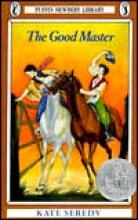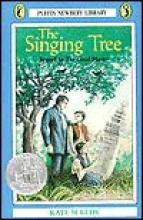History World War I
The Good Master
Subject(s):
Setting:
Grade / Age level:
Review:
The Good Master by Kate Seredy is a timeless tale of the goodness of the land and of the Faith. Set in Hungary before World War I, a young impish girl, Kate, is sent to the country because her father, a widower, cannot control her anymore. When she arrives she is a world class brat but she is tamed by her uncle through discipline and love. She is somewhat fearless and zealous to try everything the farm life has to offer and this leads her and her cousin Jancsi on many humorous farm adventures.
Throughout the story are beautiful vignettes on the wholesome Catholic life of the people, feast day celebrations, and traditions. There are also several Hungarian folk tales inspiringly told by the shepherds and an old miller. Kate finds a place to bloom and is able to give some back in return. She starts a school for Jancsi and the shepherds, teaching them to read. In the end her father, a school teacher comes to join them in the country and the improvement of his daughter overwhelms him. They convince him to stay in the country and reap the benefits of the the good life they have there.
There is much to be recommended in this story. The example of the "Good Master," Kate's uncle Marton, is the strongest in the story. His treatment of Kate is analogous to our "Good Master" in heaven. The story allows for much discussion of a father's love and the discipline involved in it. It is also a beautiful story to show the universality of the Church as we see the Faith practiced in another culture.
The story is beautifully written and illustrated. If you're lucky enough to find a hard cover version from the Sixties, you have some bonus color portraits of Kate and Jancsi, which as a child, I never tired of gazing over. The illustrations of authentic Hungarian costumes and folk art are a great addition to the story.
Recommended for grade 4+ (We read it to our young children, ages 3-8, and they loved it.)
Throughout the story are beautiful vignettes on the wholesome Catholic life of the people, feast day celebrations, and traditions. There are also several Hungarian folk tales inspiringly told by the shepherds and an old miller. Kate finds a place to bloom and is able to give some back in return. She starts a school for Jancsi and the shepherds, teaching them to read. In the end her father, a school teacher comes to join them in the country and the improvement of his daughter overwhelms him. They convince him to stay in the country and reap the benefits of the the good life they have there.
There is much to be recommended in this story. The example of the "Good Master," Kate's uncle Marton, is the strongest in the story. His treatment of Kate is analogous to our "Good Master" in heaven. The story allows for much discussion of a father's love and the discipline involved in it. It is also a beautiful story to show the universality of the Church as we see the Faith practiced in another culture.
The story is beautifully written and illustrated. If you're lucky enough to find a hard cover version from the Sixties, you have some bonus color portraits of Kate and Jancsi, which as a child, I never tired of gazing over. The illustrations of authentic Hungarian costumes and folk art are a great addition to the story.
Recommended for grade 4+ (We read it to our young children, ages 3-8, and they loved it.)
Reviewed by:
First reviewed:
1998-99
The Singing Tree
Subject(s):
Setting:
Grade / Age level:
Review:
The Singing Tree, sequel to The Good Master, is a much more serious story and takes place during World War I. Sandor, Kate's father, is drafted into the war and eventually, the Good Master, Marton Nagy, must report as well. The majority of the book tells of how the family gets along during the war years without the men of the family. Of course, Jancsi the young master steps up and, aided by a journal his father left for him, manages the farm quite well.
There is a difficult child, Lily, to be tamed in this story also, but she is easily won over by a set of puppies and the efforts of Kate and Jancsi. During the war, prisoners of war from Russia are brought into Hungary and Jancsi brings them to the farm to help with the work. A young woman and her new baby also come to live at the farm since her husband is in the war. Some orphans from the cities of Germany are sent out to the countryside and Jancsi takes them in as well. The household is lively and the wholesome life continues despite the terrible news from the war. Sandor is taken prisoner and put to work on a farm in Russia and Marton Nagy is missing in action. Jancsi, Kate and Lily travel to the front to rescue Jancsi's grandparents. Their home is near the front and the townspeople are fleeing the approaching Russians. While there, they accidently find Marton in a hospital bed. He had been injured and lost his memory. They triumphantly bring him home and he tells many stories about the war. One of the most moving is an often heard story about Christmas Eve where both sides sing Silent Night together and light matches to the newborn King. I have read the book at least ten times and cry every time I read that scene.
It is interesting to note that Hungary was on the "wrong" side in this war, yet in this story we see the people as victims of the political causes of a war which had nothing to do with them. One of the side effects of the war is an increase of racism among the people of the countryside who might not have otherwise been exposed to it. One of Mrs. Seredy's themes is that people, ordinary people, people of the land are the same in their hearts, no matter what nationality, and are connected by their shared humanity. She wrote the book in the late 1930's, on the verge of another war, and her tone is one of the hope of peace.
There is little, if any, other fiction for youth about World War I, so this work could be an important piece in a world history overview. My young children did not understand the political and nationalist themes of the story but enjoyed hearing it read tremendously. The reading level is fourth or fifth grade but it could be read at higher levels for the content.
There is a difficult child, Lily, to be tamed in this story also, but she is easily won over by a set of puppies and the efforts of Kate and Jancsi. During the war, prisoners of war from Russia are brought into Hungary and Jancsi brings them to the farm to help with the work. A young woman and her new baby also come to live at the farm since her husband is in the war. Some orphans from the cities of Germany are sent out to the countryside and Jancsi takes them in as well. The household is lively and the wholesome life continues despite the terrible news from the war. Sandor is taken prisoner and put to work on a farm in Russia and Marton Nagy is missing in action. Jancsi, Kate and Lily travel to the front to rescue Jancsi's grandparents. Their home is near the front and the townspeople are fleeing the approaching Russians. While there, they accidently find Marton in a hospital bed. He had been injured and lost his memory. They triumphantly bring him home and he tells many stories about the war. One of the most moving is an often heard story about Christmas Eve where both sides sing Silent Night together and light matches to the newborn King. I have read the book at least ten times and cry every time I read that scene.
It is interesting to note that Hungary was on the "wrong" side in this war, yet in this story we see the people as victims of the political causes of a war which had nothing to do with them. One of the side effects of the war is an increase of racism among the people of the countryside who might not have otherwise been exposed to it. One of Mrs. Seredy's themes is that people, ordinary people, people of the land are the same in their hearts, no matter what nationality, and are connected by their shared humanity. She wrote the book in the late 1930's, on the verge of another war, and her tone is one of the hope of peace.
There is little, if any, other fiction for youth about World War I, so this work could be an important piece in a world history overview. My young children did not understand the political and nationalist themes of the story but enjoyed hearing it read tremendously. The reading level is fourth or fifth grade but it could be read at higher levels for the content.
Reviewed by:
First reviewed:
1998-99


